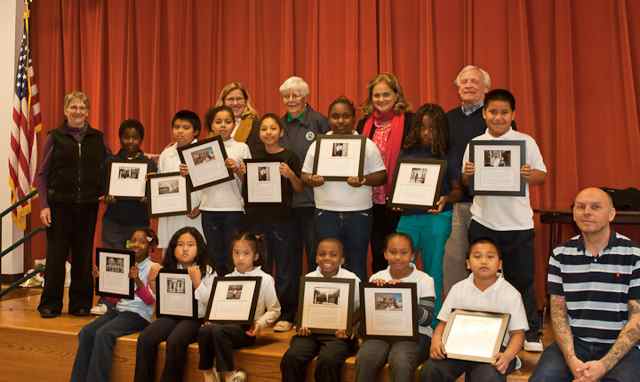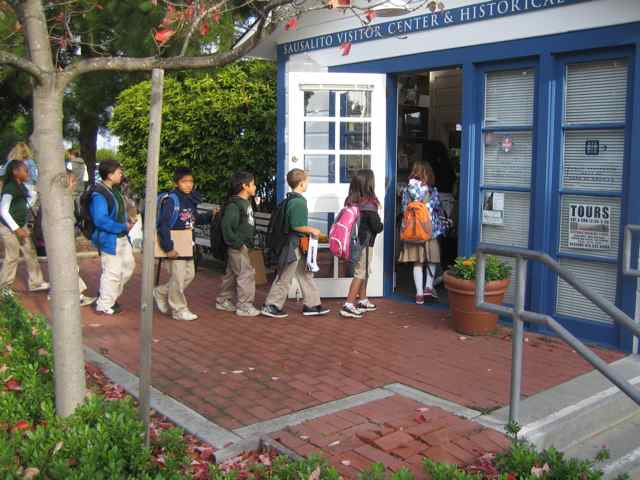Keeping History Alive
 Thursday, February 24, 2011 at 12:00PM
Thursday, February 24, 2011 at 12:00PM By Larry Clinton, President, Sausalito Historical Society
Last fall, the Historical Society officially launched a schools program with the third grade classes from Bayside School and Willow Creek Academy, and with the support of the Sausalito Public School District. The program includes classroom visits and field trips led by SHS docents.
During the classroom presentation, docents introduce students to the history of Sausalito using books, artifacts and "Then and Now" student workbooks filled with photos, maps, historical facts and space for the students to add their own research notes. The teachers then work with the students to research a particular building or site and write a paragraph on what they learned about their building and what it tells them about the history of the town.
On the field trips, docents lead students, teachers and parents on a tour of the areas and buildings the students are in the process of researching. Students also have their photos taken in front of their chosen building or site. The classes then have lunch in either Marinship or Gabrielson Park and enjoy an ice cream treat.
Historic sites visited by the third-graders last Fall include the Ice House, Viña del Mar Park, and the present-day Sausalito Hotel, Winship’s Restaurant, Don Olsen Associates, Jewelry By the Bay, Scoma’s, Horizons, Galerie Engelstad, Georgiou Boutique, Marin Fruit Company, Crazy Shirts, Gene Hiller Menswear and Poggio Trattoria.
In a final awards ceremony involving both classes, school administrators and parents, students receive recognition of their accomplishments in the form of framed photos from their field trips and their written research, courtesy of the Sausalito Historical Society and Sausalito Picture Framing.
With the cooperation of the Sausalito School District, teachers and parents, the SHS conducted two programs in 2010, with two more in the Spring and Fall of 2011. The Society plans to continue this program with two programs each subsequent year, focusing on different aspects of Sausalito history. Each program involves approximately 40-50 students, over a dozen docents, numerous parents, school administrators and local businesses.
Assessing the effectiveness of last year's programs, teacher Paula Hammons of Bayside School wrote: "Thank you ever so much for the wonderful field trip experience: exploring Sausalito's downtown historic district. The children (and adults) were engaged and stimulated by the wealth of information you shared. We all learned a great deal. Your impeccable preparation helped to make this a memorable day for all of us."
Willow Creek teacher Ann Siskin added: “My third grade social studies curriculum and instruction would not be the same without this exceptional educational partnership! The program has provided students with hands-on, experiential learning opportunities that help bring our community’s history alive. The program has encouraged memorable learning for every student.” And Superintendent Debra Bradley summed up the impact of the program with "I cannot say enough about the Sausalito Historical Society and how their efforts have brought richness to our students in both historical exposure, and personalized recognition to each of our students. Needless to say, the parents are thrilled as well and attend the recognition assembly with cameras in hand."
Feedback like this is the best measure of the program's success.
SHS members contributed over $3,400 to offset the costs of last year's program, in response to a year end fundraising letter. Waterstreet Hardware, Lappert's Ice Cream and Sausalito Picture Framing provided in-kind donations to help with last year's programs.

Bayside School third graders proudly display photos from their field trip, after receiving congratulations from teacher Paula Hammons (l.) and Historical Society members including Schools Program co-chairs Susan Frank (second from right, top row), and Bob Woodrum (bottom right).

Willow Creek students visit the Historical Society’s Ice House historical display and visitors center during their Fall field trip.
Photos courtesy of Sausalito Historical Society


